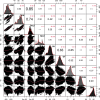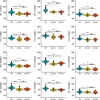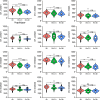Genome-wide association study reveals 18 QTL for major agronomic traits in a Nordic-Baltic spring wheat germplasm
- PMID: 38974985
- PMCID: PMC11224466
- DOI: 10.3389/fpls.2024.1393170
Genome-wide association study reveals 18 QTL for major agronomic traits in a Nordic-Baltic spring wheat germplasm
Abstract
Spring wheat (Triticum aestivum L.) remains an important alternative to winter wheat cultivation at Northern latitudes due to high risk of overwintering or delayed sowing of winter wheat. We studied nine major agronomic traits in a set of 299 spring wheat genotypes in trials across 12-year-site combinations in Lithuania, Latvia, Estonia, and Norway for three consecutive years. The dataset analyzed here consisted of previously published phenotypic data collected in 2021 and 2022, supplemented with additional phenotypic data from the 2023 field season collected in this study. We combined these phenotypic datasets with previously published genotypic data generated using a 25K single nucleotide polymorphism (SNP) array that yielded 18,467 markers with a minor allele frequency above 0.05. Analysis of these datasets via genome-wide association study revealed 18 consistent quantitative trait loci (QTL) replicated in two or more trials that explained more than 5% of phenotypic variance for plant height, grain protein content, thousand kernel weight, or heading date. The most consistent markers across the tested environments were detected for plant height, thousand kernel weight, and days to heading in eight, five, and six trials, respectively. No beneficial effect of the semi-dwarfing alleles Rht-B1b and Rht-D1b on grain yield performance was observed across the 12 tested trials. Moreover, the cultivars carrying these alleles were low yielding in general. Based on principal component analysis, wheat genotypes developed in the Northern European region clustered separately from those developed at the southern latitudes, and markers associated with the clustering were identified. Important phenotypic traits, such as grain yield, days to heading, grain protein content, and thousand kernel weight were associated with this clustering of the genotype sets. Interestingly, despite being adapted to the Nordic environment, genotypes in the Northern set demonstrated lower grain yield performance across all tested environments. The results indicate that spring wheat germplasm harbors valuable QTL/alleles, and the identified trait-marker associations might be useful in improving Nordic-Baltic spring wheat germplasm under global warming conditions.
Keywords: GWAS; Nordic region; QTL; Triticum aestivum; yield-related traits.
Copyright © 2024 Aleliūnas, Gorash, Armonienė, Tamm, Ingver, Bleidere, Fetere, Kollist, Mroz, Lillemo and Brazauskas.
Conflict of interest statement
The authors declare that the research was conducted in the absence of any commercial or financial relationships that could be construed as a potential conflict of interest.
Figures







Similar articles
-
Genome-wide association study for agronomic and physiological traits in spring wheat evaluated in a range of heat prone environments.Theor Appl Genet. 2017 Sep;130(9):1819-1835. doi: 10.1007/s00122-017-2927-z. Epub 2017 Jun 2. Theor Appl Genet. 2017. PMID: 28577083
-
Genome-wide association studies of seven agronomic traits under two sowing conditions in bread wheat.BMC Plant Biol. 2019 Apr 17;19(1):149. doi: 10.1186/s12870-019-1754-6. BMC Plant Biol. 2019. PMID: 31003597 Free PMC article.
-
QTL mapping for grain yield and three yield components in a population derived from two high-yielding spring wheat cultivars.Theor Appl Genet. 2021 Jul;134(7):2079-2095. doi: 10.1007/s00122-021-03806-1. Epub 2021 Mar 9. Theor Appl Genet. 2021. PMID: 33687497 Free PMC article.
-
Quick mapping and characterization of a co-located kernel length and thousand-kernel weight-related QTL in wheat.Theor Appl Genet. 2022 Aug;135(8):2849-2860. doi: 10.1007/s00122-022-04154-4. Epub 2022 Jul 8. Theor Appl Genet. 2022. PMID: 35804167 Review.
-
Genes Impacting Grain Weight and Number in Wheat (Triticum aestivum L. ssp. aestivum).Plants (Basel). 2022 Jul 4;11(13):1772. doi: 10.3390/plants11131772. Plants (Basel). 2022. PMID: 35807724 Free PMC article. Review.
Cited by
-
GWAS analysis of Fusarium head blight resistance in a Nordic-Baltic spring wheat panel.Front Plant Sci. 2025 Jul 23;16:1604296. doi: 10.3389/fpls.2025.1604296. eCollection 2025. Front Plant Sci. 2025. PMID: 40772045 Free PMC article.
-
Identification of a novel dwarfing gene, Rht_m097, on chromosome 4BS in common wheat.Mol Breed. 2025 Apr 3;45(4):38. doi: 10.1007/s11032-025-01558-0. eCollection 2025 Apr. Mol Breed. 2025. PMID: 40191669
References
-
- Bates D., Mächler M., Bolker B. M., Walker S. C. (2015). Fitting linear mixed-effects models using lme4. J. Stat. Softw. 67, 1–48. doi: 10.18637/jss.v067.i01 - DOI
-
- Diederichsen A., Solberg S., Jeppson S. (2013). Morphological changes in Nordic spring wheat (Triticum aestivum L.) landraces and cultivars released from 1892 to 1994. Genet. Resour Crop Evol. 60, 569–585. doi: 10.1007/s10722-012-9858-y - DOI
LinkOut - more resources
Full Text Sources

